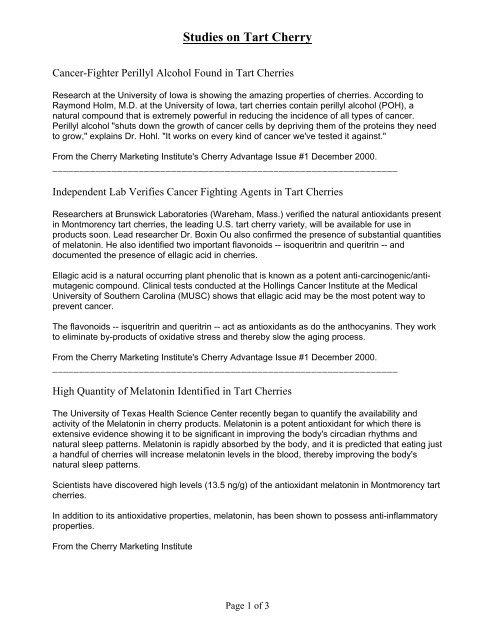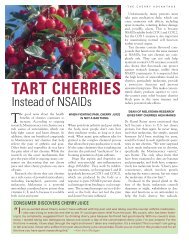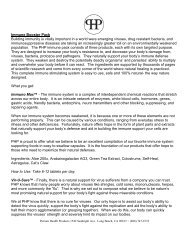Cancer-Fighter Perillyl Alcohol Found in Tart Cherries
Cancer-Fighter Perillyl Alcohol Found in Tart Cherries
Cancer-Fighter Perillyl Alcohol Found in Tart Cherries
Create successful ePaper yourself
Turn your PDF publications into a flip-book with our unique Google optimized e-Paper software.
Studies on <strong>Tart</strong> Cherry<br />
<strong>Cancer</strong>-<strong>Fighter</strong> <strong>Perillyl</strong> <strong>Alcohol</strong> <strong>Found</strong> <strong>in</strong> <strong>Tart</strong> <strong>Cherries</strong><br />
Research at the University of Iowa is show<strong>in</strong>g the amaz<strong>in</strong>g properties of cherries. Accord<strong>in</strong>g to<br />
Raymond Holm, M.D. at the University of Iowa, tart cherries conta<strong>in</strong> perillyl alcohol (POH), a<br />
natural compound that is extremely powerful <strong>in</strong> reduc<strong>in</strong>g the <strong>in</strong>cidence of all types of cancer.<br />
<strong>Perillyl</strong> alcohol "shuts down the growth of cancer cells by depriv<strong>in</strong>g them of the prote<strong>in</strong>s they need<br />
to grow," expla<strong>in</strong>s Dr. Hohl. "It works on every k<strong>in</strong>d of cancer we've tested it aga<strong>in</strong>st."<br />
From the Cherry Market<strong>in</strong>g Institute's Cherry Advantage Issue #1 December 2000.<br />
________________________________________________________________<br />
Independent Lab Verifies <strong>Cancer</strong> Fight<strong>in</strong>g Agents <strong>in</strong> <strong>Tart</strong> <strong>Cherries</strong><br />
Researchers at Brunswick Laboratories (Wareham, Mass.) verified the natural antioxidants present<br />
<strong>in</strong> Montmorency tart cherries, the lead<strong>in</strong>g U.S. tart cherry variety, will be available for use <strong>in</strong><br />
products soon. Lead researcher Dr. Box<strong>in</strong> Ou also confirmed the presence of substantial quantities<br />
of melaton<strong>in</strong>. He also identified two important flavonoids -- isoqueritr<strong>in</strong> and queritr<strong>in</strong> -- and<br />
documented the presence of ellagic acid <strong>in</strong> cherries.<br />
Ellagic acid is a natural occurr<strong>in</strong>g plant phenolic that is known as a potent anti-carc<strong>in</strong>ogenic/antimutagenic<br />
compound. Cl<strong>in</strong>ical tests conducted at the Holl<strong>in</strong>gs <strong>Cancer</strong> Institute at the Medical<br />
University of Southern Carol<strong>in</strong>a (MUSC) shows that ellagic acid may be the most potent way to<br />
prevent cancer.<br />
The flavonoids -- isqueritr<strong>in</strong> and queritr<strong>in</strong> -- act as antioxidants as do the anthocyan<strong>in</strong>s. They work<br />
to elim<strong>in</strong>ate by-products of oxidative stress and thereby slow the ag<strong>in</strong>g process.<br />
From the Cherry Market<strong>in</strong>g Institute's Cherry Advantage Issue #1 December 2000.<br />
________________________________________________________________<br />
High Quantity of Melaton<strong>in</strong> Identified <strong>in</strong> <strong>Tart</strong> <strong>Cherries</strong><br />
The University of Texas Health Science Center recently began to quantify the availability and<br />
activity of the Melaton<strong>in</strong> <strong>in</strong> cherry products. Melaton<strong>in</strong> is a potent antioxidant for which there is<br />
extensive evidence show<strong>in</strong>g it to be significant <strong>in</strong> improv<strong>in</strong>g the body's circadian rhythms and<br />
natural sleep patterns. Melaton<strong>in</strong> is rapidly absorbed by the body, and it is predicted that eat<strong>in</strong>g just<br />
a handful of cherries will <strong>in</strong>crease melaton<strong>in</strong> levels <strong>in</strong> the blood, thereby improv<strong>in</strong>g the body's<br />
natural sleep patterns.<br />
Scientists have discovered high levels (13.5 ng/g) of the antioxidant melaton<strong>in</strong> <strong>in</strong> Montmorency tart<br />
cherries.<br />
In addition to its antioxidative properties, melaton<strong>in</strong>, has been shown to possess anti-<strong>in</strong>flammatory<br />
properties.<br />
From the Cherry Market<strong>in</strong>g Institute<br />
Page 1 of 3
Studies on <strong>Tart</strong> Cherry<br />
Michigan State University First to Identify Anthocyan<strong>in</strong>s <strong>in</strong> <strong>Tart</strong> <strong>Cherries</strong><br />
"Twenty cherries provide 25 mg of anthocyan<strong>in</strong>s which help shut down the enzymes that cause<br />
tissue <strong>in</strong>flammation <strong>in</strong> the first place, so cherries can prevent and treat many k<strong>in</strong>ds of pa<strong>in</strong>", states<br />
Dr. Nair, Michigan State University Researcher. Anthocyan<strong>in</strong>s are plant pigments responsible for<br />
the bright red color of cherries. These pigments are known to have antioxidant activity and<br />
antioxidants are believed to play a role <strong>in</strong> reduc<strong>in</strong>g the risk of various human degenerative<br />
diseases. <strong>Tart</strong> cherries conta<strong>in</strong> anthocyan<strong>in</strong>s and flavonoids which <strong>in</strong>hibit the enzymes and prevent<br />
<strong>in</strong>flammation <strong>in</strong> the body. These compounds have similar activity as aspir<strong>in</strong>, naproxen, and<br />
ibuprofen. The anthocyan<strong>in</strong>s may also protect artery walls from the damage that leads to plaque<br />
buildup and heart disease. Recent studies show that anthocyan<strong>in</strong>s do a better job of protect<strong>in</strong>g<br />
arteries than vitam<strong>in</strong>s C and E.<br />
There are 17 antioxidants <strong>in</strong> tart cherries. Two of these, anthocyan<strong>in</strong>s 1 and 2, can <strong>in</strong>hibit the<br />
cyclooxygenase (COX) enzymes which are associated with the pa<strong>in</strong> of arthritis and gout. In<br />
comparison of 10 small fruits, cherries had the highest level of anthocyan<strong>in</strong>s 1 and 2. Anthocyan<strong>in</strong>s<br />
1 and 2 are NOT present <strong>in</strong> blueberries or cranberries.<br />
From the Cherry Market<strong>in</strong>g Institute<br />
________________________________________________________________<br />
Melaton<strong>in</strong><br />
What's new on MELATONIN?<br />
As we grow older we produce less and less melaton<strong>in</strong>. Also, if there is some sort of trauma <strong>in</strong> our<br />
lives at any time we do not produce as much Melaton<strong>in</strong>. This could have a great deal to do with<br />
why people are not sleep<strong>in</strong>g well. Perhaps it is more than stress. It is because they are not<br />
produc<strong>in</strong>g enough Melaton<strong>in</strong> to tell them that it is time to sleep. <strong>Tart</strong> Cherry Juice Concentrate is<br />
loaded with Melaton<strong>in</strong>.<br />
Dr. Russell Reiter, University of Texas Health Science Center, is said to be the Dean of Melaton<strong>in</strong><br />
Research and he gives cherries high marks. We were surprised at how much Melaton<strong>in</strong> was <strong>in</strong><br />
cherries, specifically the Montmorency variety, says Reiter. And <strong>Tart</strong> Cherry Juice Concentrate,<br />
which <strong>in</strong>volves greatly reduc<strong>in</strong>g the water content, has ten times the Melaton<strong>in</strong> of the raw fruit. <strong>Tart</strong><br />
<strong>Cherries</strong> conta<strong>in</strong> an extremely significant quantity of melaton<strong>in</strong>, enough to produce positive results<br />
<strong>in</strong> the body.<br />
Montmorency cherries, which account for the majority of tart cherries produced <strong>in</strong> the United<br />
States, conta<strong>in</strong> up to 13.5 nanograms (ng) of melaton<strong>in</strong> per gram of cherries, more than is normally<br />
found <strong>in</strong> the blood. Melaton<strong>in</strong> is by far the most potent of the antioxidants, much more so than<br />
vitam<strong>in</strong>s C, E and A. The reason: melaton<strong>in</strong> is soluble both <strong>in</strong> fat and water and can therefore enter<br />
some cells that vitam<strong>in</strong>s cannot. For example, vitam<strong>in</strong> E is soluble <strong>in</strong> the lipid part of the cell only<br />
and vitam<strong>in</strong> Compounds (called limonenes) are used as food additives and are found <strong>in</strong> the blood.<br />
Melaton<strong>in</strong> is by far the potent of the antioxidants, much more so than vitam<strong>in</strong>s C, E, and A. The<br />
reason: melaton<strong>in</strong> is soluble both <strong>in</strong> fat and water and can therefore enter some cells that vitam<strong>in</strong>s<br />
cannot. For example, vitam<strong>in</strong> E is soluble <strong>in</strong> the lipid part of the cell only and vitam<strong>in</strong> C <strong>in</strong> the<br />
aqueous part. Melaton<strong>in</strong> is soluble <strong>in</strong> both. For this reason, Dr. Reiter says, eat<strong>in</strong>g cherries with<br />
high melaton<strong>in</strong> concentrations will <strong>in</strong>crease the antioxidant capacity <strong>in</strong> the body.<br />
From the Cherry Market<strong>in</strong>g Institute's Cherry Advantage Issue #3 December 2002.<br />
Page 2 of 3
Antioxidants<br />
Studies on <strong>Tart</strong> Cherry<br />
Researchers at Brunswick Laboratories (Wareham, MA) verified the natural antioxidants present <strong>in</strong><br />
Montmorency tart cherries. Lead researcher Dr. Box<strong>in</strong> Ou also identified two important flavonoids:<br />
isoqueritr<strong>in</strong> and queritr<strong>in</strong>. These antioxidants work to elim<strong>in</strong>ate by-products of oxidative stress and<br />
thereby slow the ag<strong>in</strong>g process.<br />
He also documented the presence of ellagic acid <strong>in</strong> cherries. Ellagic acid is a naturally-occurr<strong>in</strong>g<br />
plant phenolic that is known as a potent anti-carc<strong>in</strong>ogenic/antimutagenic compound. Cl<strong>in</strong>ical tests<br />
conducted at the Holl<strong>in</strong>gs <strong>Cancer</strong> Institute at the Medical University of South Carol<strong>in</strong>a show that<br />
ellagic acid may be the most potent way to prevent cancer. It also may <strong>in</strong>hibit the growth of cancer<br />
cells and arrest the growth of cancer <strong>in</strong> subjects with a genetic predisposition for the disease.<br />
From the Cherry Market<strong>in</strong>g Institute's Cherry Advantage Issue #1 December 2000.<br />
________________________________________________________________<br />
<strong>Tart</strong> Cherry Anthocyan<strong>in</strong>s Inhibit Tumor Development<br />
New studies at Michigan State University (MSU), which were recently published <strong>in</strong> <strong>Cancer</strong> Letters,<br />
suggest the tart cherries may reduce the risk of colon cancer because of the anthocyan<strong>in</strong>s nd<br />
cyanid<strong>in</strong> conta<strong>in</strong>ed <strong>in</strong> the cherry. Dr. Mauraleedharan Nair and Dr. Leslie Bourgu<strong>in</strong> along with<br />
several graduate students worked on experiments that are part of ongo<strong>in</strong>g research on the<br />
components of tart cherries.<br />
Page 3 of 3





